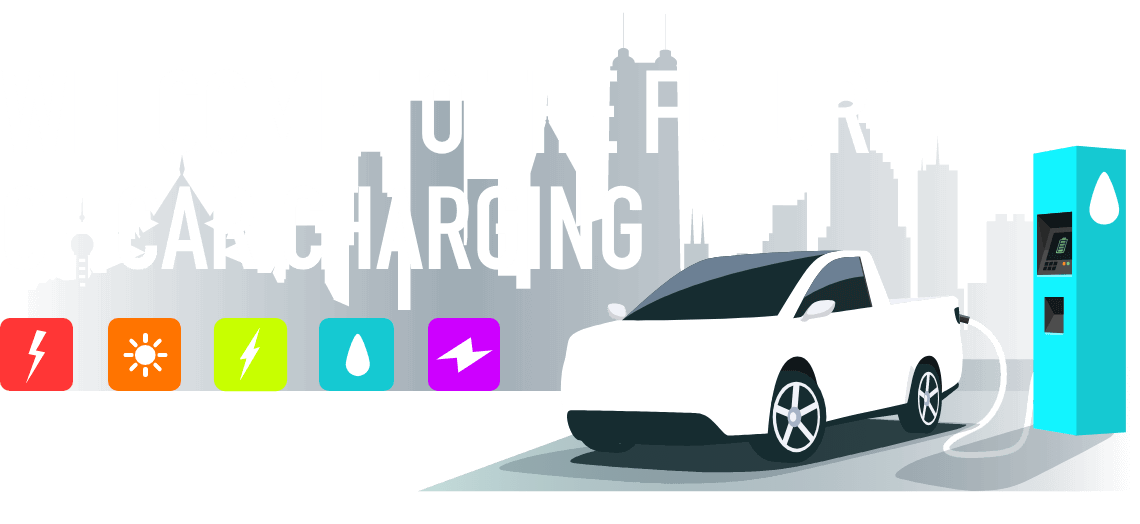
The Burrow

Ever since Carl Benz patented his three-wheeled motor car in 1886, vehicle technology has evolved at a rapid pace. The next 10-20 years are set to be a revolution for electric cars. We’ve seen them being developed more rapidly with each passing year, as more manufacturers introduce them into their fleets and governments around the world continue to implement more charging infrastructure.
As experts in car insurance, we were curious to know how we might be charging these vehicles in the future. In this article we explore what five different charging stations could hypothetically look like in the future. The charging stations we’re examining are fast-charging, solar-powered, wireless, hydrogen fuel and dynamic conductive charging and this technology is either already in use or in development today.

We’ve picked 10 countries that currently have the highest amount of electric vehicle sales1 to conceptualise what different electric car charging technology could look like in the future.
Here are the 10 countries we will explore in this article:
How could charging stations look in the future?
![]()
fast-charging stations
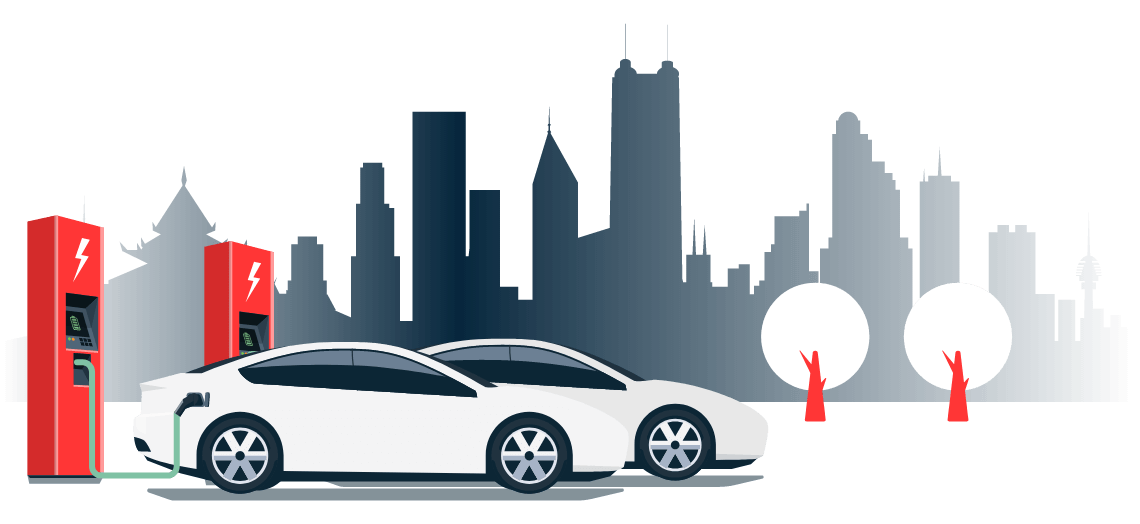
Charging an electric vehicle can take hours. Not super convenient if you’re already running late or just want to pop to the shops.
Enter the fast-charging stations.
These advanced charging stations may mean that cities might require upgrades to their energy grids, and for home use, smart meters or charging methods may need to be adopted that involve charging at off-peak periods, as noted by Julian de Hoog et al.1
Converting existing petrol stations to fast-charging electric vehicle charge points could help to meet the needs of highly trafficked routes in major cities and suburban areas supported by a strong energy network.
It isn’t just at a converted petrol station that these fast-charging electric car stations could reside in. They may pop up in public areas of major cities, suburbs, towns, and would become available for private use at home as well.
Because most people charging an electric vehicle do so at night,2 being able to meet increased demand during peak periods will be crucial to facilitate people installing a fast-charging port in their own home.
The fast-charging technology of today is widely used around the globe, and can provide an electric car with a 160-kilometre (100-mile) charge in 10 minutes at 250 kilowatts (kW).3
Increasing the charge to 400kW is believed to satisfy the charging requirements for most long-distance journeys, according to Thomas Bryden et al.4
Providing more powerful, faster-charging stations requires advancements in electric car battery technology to ensure an efficient delivery – so that no energy is ‘lost’ due to inefficiencies or an issue on the battery side of the electric car.
Fast charging also generates a lot of heat, which can hurt the efficiency of the car’s battery. Such heat could also cause physical damage from an overheating charger melting components.
Liquid-cooling and air-cooling technology are already utilised in current fast-charging electric car stations and batteries, to avoid high temperatures. So, we could expect to continue to see this technology in the fast-charging stations of the future.
Liquid-cooling is more effective than air-cooling, according to Ryan Collin et al.’s article ‘Advanced Electric Vehicle Fast-Charging Technologies’,5 which could mean we are likely to see liquid-cooling methods used in the future’s more advanced fast-charging stations.
Despite likely widespread popularity, research shows the following cities may be frontrunners in adopting these stations due to being busy trade, business and financial hubs within their respective countries and globally. A fast-moving economic district may find fast-charging stations appealing for a growing fleet of electric vehicles.
China is one of the world’s largest markets for electric cars, making up half of all global electric vehicle sales. In 2018, China sold 2.3 million electric vehicles (including plug-in hybrid electric vehicles or PHEVs as well as BEVs), according to Virta Global’s report.6
It won’t be hard to imagine major Chinese cities like Beijing or Shanghai transforming their existing petrol stations into fast-charging electric car recharge points, as the Global Energy Network Institute notes these cities are connected by 500kW energy grids.7 However, our example takes a look at the city of Shenzen.
Shenzen is the highest-ranking city from mainland China on the Global Financial Centres Index (GFCI) rankings,8 as a large amount of trade and business happens there. Such a fast-moving city could need fast charging stations for a growing amount of electric cars in the future.
The fuel and energy company Royal Dutch Shell has already begun adding electric car charging stations to existing petrol stations in parts of London since 2017.9 The United Kingdom (UK) saw 99,437 new battery electric vehicles (BEVs) sold in 201910 alone. London is also the financial capital of the UK and ranks at number two in the world on the GFCI.11
While many big cities in America may embrace fast-charging tech, it’s hard to go past a city more iconic than New York, ‘the city that never sleeps.’ As the fast-moving financial, trade and business capital of the world (taking the top spot on the GFCI rankings)12 it’s plausible that the ‘Big Apple’ will want to keep a growing fleet of electric cars charged and ready to go quickly.
Many European countries are actively transitioning to electric vehicles alongside renewable energy and increased energy efficiency. One such example is Switzerland.
By 2035, Switzerland’s energy consumption per capita will be reduced by 35%,13 providing ample network stability for home use of fast-charging stations across major cities, such as Zurich. Zurich is renowned for being Switzerland’s trade and financial capital, and is the highest ranking city from Switzerland on the GFCI rankings.14
![]()
solar charging stations

Electric cars are designed to be environmentally friendly alternatives to petrol or diesel vehicles. But what if the electricity is generated by burning fossil fuels?
Fortunately, solar-powered car charging stations provide completely clean energy for your vehicle.
Solar charging stations are most likely appear where it is sunniest and may not be as common at ground level in cities full of skyscrapers that could block out direct sunlight.
For example, there are currently plans to build some solar charging stations in rural California,15 which aren’t connected to existing energy grids but supply their own power.
Solar power provides a unique opportunity for charging stations. Not only can it provide clean electricity, but it can do so on its own network, charging the electric vehicle recharge station directly. This means that the charging point doesn’t need to rely on an existing grid or infrastructure and can power itself.
The key challenge with solar power is that it can be affected by the weather and won’t always run at full efficiency. Advanced battery storage can be used alongside more efficient solar panels to store solar energy for use as needed to overcome this challenge, regardless of whether the sun is shining or not, as noted by the CSIRO, who are testing this solar charging technology.16
Recent advancements in solar technology have shown that two-square metres of transparent perovskite cells are equally efficient to larger solar panels that take up an entire roof. These cells can also be used as windows in buildings to harness even more solar energy.17
While this means solar panels may be smaller and potentially easier to fit in built-up urban areas, solar-powered charging stations will likely not appear in major cities due to skyscrapers blocking out direct light.
Some prime examples of where we could see this technology include:
We’ve taken a look at a few cities that receive higher amounts of sunlight, and are positioned to make the most of their natural solar potential.
Several cities in the US, such as Phoenix (Arizona), San Antonio or Dallas (Texas), and Albuquerque (New Mexico) are already well-placed to take advantage of more efficient solar stations in the future.
Each city experiences plenty of sun and already has several solar power farms in place.18
The United Nations Environment Programme notes that southern France, Austria and Germany receive more natural sunlight than other countries on this list.19 The south of France sits on the Mediterranean and gets plenty of sunshine, so cities like Marseille, or the city of Nice, may utilise solar charging technology for electric cars in the future.
Freiburg in Germany is noted by Germany’s tourism department as being one of the sunniest cities in the country.20 As Germany’s fleet of electric vehicles continues to grow, Freiburg may be able to take advantage of its high amounts of sunshine to power them.
As mentioned above, southern Austria receives more sunshine than the rest of the country. The lakeside town of Klagenfurt is regarded as one of the warmest and sunniest spots in the country, according to the Austrian National Tourist Office.21
![]()
wireless charging stations
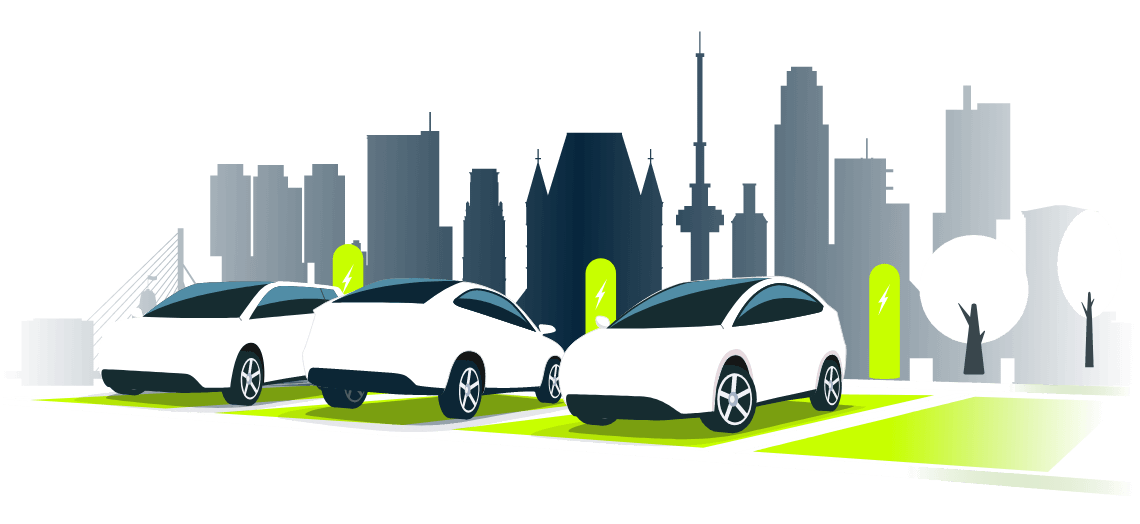
Recent years have seen wireless charging technology become more common in hand-held devices. For instance, you can now place your mobile phone on a pad, which charges your phone without you needing to grab your cable and plug it in.
Such convenience is making its way into car recharging stations – and could be available in some cities around the world in the years to come.
We may see wireless charging technology in people’s homes or public spaces with plenty of car parks, based on where trials of this technology are planned (see below).
The city of Oslo in Norway has partnered with Finnish energy company Fortum and American tech company Momentum Dynamics to install a series of wireless electric car charging stations in Oslo for taxis.22
These charging stations work by having a charging plate on the ground that sits underneath the car when it’s parked over a designated parking spot. This plate then recharges the car’s battery over time.
The arrival of wireless charging is due to coincide with Oslo’s plans to have a completely emission-free fleet of taxis by 2023.
Wireless car charging stations could naturally suit communal parking places where drivers can park their car and come back to a fully charged ride. This could include shopping centres, public car parks in the street and new multi-level car parks.
One of the key issues with this technology is that while brand new infrastructure projects can incorporate wireless electric car charging, existing parking spaces would have to be dug up and rebuilt.
Wireless electric car charging tech is still being developed and trialled. The cities we’ve explored with our concept graphic are known for being a technological hub within their respective countries, and may have more investment or infrastructure in place for this exciting charging technology.
As mentioned above, Norway’s capital of Oslo is one of the first cities to start trialling wireless charging technology, and may expand the usage of this tech further across the city and other Norwegian towns such as Bergen.
While Oslo is leading the way, other cities where this tech could be seen could include San Francisco or Palo Alto in the United States – the home of ‘Silicon Valley,’ where several tech and software companies are based.
When it comes to Belgium, the city of Antwerp is embracing modern and future technology to help make it a ‘smart city’ with a big focus on using IT for logistics and mobility.23 This may see Antwerp, and other Belgian cities, embrace advanced tech like wireless charging stations for electric cars.
![]()
hydrogen fuelling stations
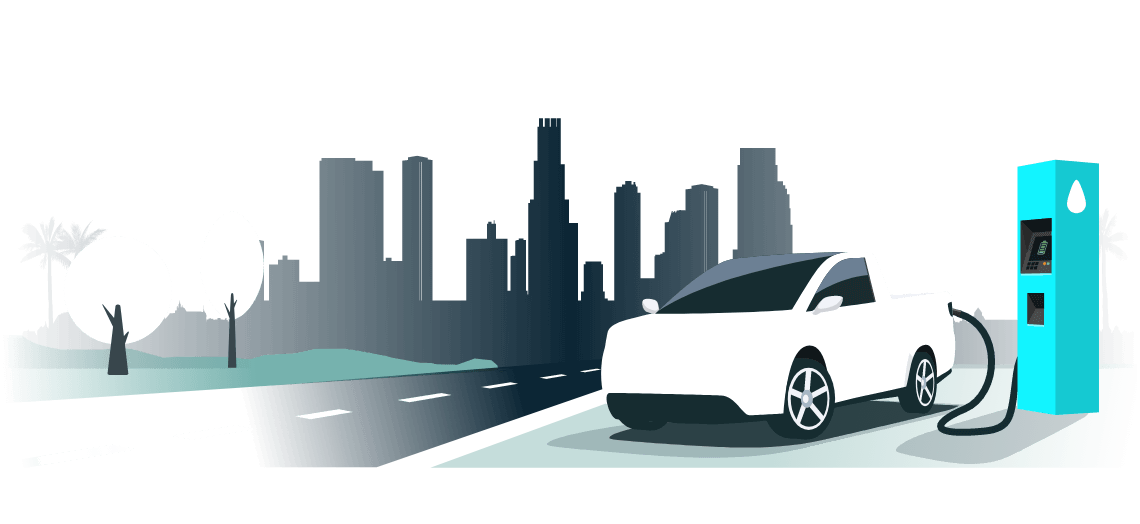
One very different method of recharging cars is with hydrogen fuel instead of electricity. This alternative method consists of using hydrogen fuel cells – a clean energy source – that converts liquid hydrogen into electricity by passing it through two electrodes.24
Unlike fossil fuels, hydrogen fuel is a completely eco-friendly energy source. Hydrogen is also the most common element in the universe.25
As hydrogen fuel is a liquid, refuelling a hydrogen car’s tank is just as quick as using petrol or diesel fuels.26 This can save you time, even when compared with fast-charging electric charging stations.
Hydrogen fuel does face several issues before it could be employed across the world.
Firstly, current technology is not as efficient as electric batteries due to hydrogen fuel cells having a shorter life cycle, as noted in the Norwegian Ministry of Petroleum and Energy’s white paper, Power to change – Energy Policy Towards 2030.27
Hydrogen fuel stations also require similar infrastructure to petrol stations – as there is a refuelling bowser connected to a large storage tank. Outside of appropriating existing petrol stations or establishing new hydrogen refuelling stops, this technology might not fit where other electric recharging stations can, such as in built up urban environments or large multi-level carparks.
Lastly, while there are a few hydrogen-fuelled cars available today, the limited amount of refuelling stations that supply hydrogen fuel means that there are typically only a few places currently where you can refuel a hydrogen-powered car. This limits the range that drivers can take their hydrogen cars and is another obstacle to be overcome.
Additionally, hydrogen-powered cars are more expensive than other eco-friendly alternatives due to the use of platinum in the fuel cell,28 which is an expensive element.
In the future, however, these cars may become less expensive as costs, efficiencies and technology improve and become more available. If hydrogen cars become more popular, there will be an increased demand for hydrogen fuelling stations.
Hydrogen-fuelled cars could be more common in cities that have already begun adopting hydrogen fuel and are well placed to establish a wider network of refuelling stations.
California has led the way by establishing a network of hydrogen fuel stations across the state to encourage more drivers to buy hydrogen-powered cars.29 Cities such as San Francisco, Sacramento and Los Angeles are key hydrogen fuel hubs in Hollywood’s home state. The more charging stations that are available, the further people may be able to go with hydrogen vehicles, which could make them more appealing to drivers.
A study by the International Energy Agency (IEA) noted that The Hague is one city in the Netherlands already has significant hydrogen fuel infrastructure established,30 so we may see more hydrogen fuel stations appear in The Hague in the future if hydrogen-powered cars become more popular.
Other cities around the globe may also see more hydrogen fuel stations appear, like Cobham in the United Kingdom. Cobham was the first town in the UK to have a hydrogen fuelling station in 2017 when Royal Dutch Shell partnered with ITM Power.31
![]()
Dynamic Conductive Charging
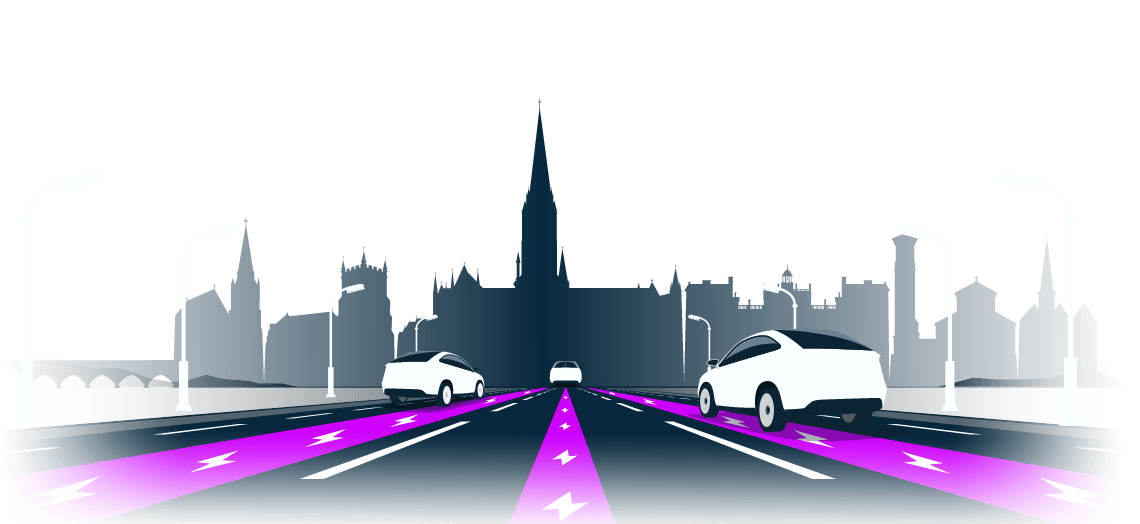
The previous examples of electric car charging stations are designed to work when the vehicle is stationary and parked in place – but what if it was possible to charge an electric car while it was still on the move?
This technology involves a charged rail or track that runs down the centre of the road, which cars can connect to. Alternatives include a track along the side of the road connected horizontally to the car, or via overhead wires like that of a tram.32
While overhead wires could only be reached by taller vehicles, and horizontal charging from the side of the road can only be reached by the side-most lanes, tracks which run underneath the car in each lane could be used by any vehicle which has a conductor attached to the track.
Having the ability to charge while on the move reduces the downtime electric freight and public transport vehicles need to recharge, which helps keep people and goods moving where they need to go.
Some parts of the world are trialling this on-road technology as of 2020.
In Lund, Sweden, companies such as EVolution Road and Elonroad have partnered with the provincial transport authority Skånetrafiken and the Municipality of Lund to begin a three-year trial of electric road tech.33
Trials for overhead wire dynamic conductive charging have also been underway since 2016 in Sandviken, Sweden on a test track.34
There are two key obstacles to overcome for dynamic conductive technology – proving that the technology:
As Collin et al. discuss in their article, dynamic conductive charging could be unsafe to the human touch and be affected by water, dirt, snow, debris and ice.35
Furthermore, electric rails could limit the mobility of electric vehicles and force drivers down certain paths, so careful road and infrastructure planning will need to be implemented to ensure a steady, effective flow of traffic.
There is the potential for this form of recharging to cross over with wireless charging to create electric roads that charge vehicles as they pass over it.36 This technology could look similar to dynamic conductive electric charging, just without the conductor connecting the electric road to the car.
As for where we could see this technology in the future, several European countries have discussed plans for electric roads (or in the case of Sweden, have already started trials). A key factor for where we could see this technology may be roads that are easy to navigate and have lower congestion to make it less complicated for the driver to stay on the charging lane to power up their car.
The Norwegian Public Roads Administration has published reports that include a proposed electric coastal highway from Trondheim to Kristiansand.37 Should this project be successful, several cities in Norway could utilise this technology.
In Germany, the company Siemens was commissioned in 2017 to build a dynamic conductive charging road for freight trucks between Frankfurt Airport and Weiterstadt and the city of Darmstadt.38
Long Beach also has an electric road system that began testing in 2017, which is similar to a project underway on a stretch of highway in Vallée de la Seine in France.39
The mayor and city planners of Kunming in China met with city planners from the United States city of Portland to share city planning strategies in 2016. The city of Kunming plans to reduce carbon emissions and better manage its density.40 Future-proofing and road planning to manage density and congestion might make it easier for Kunming to adopt dynamic conductive charging technology in the future.
Electric cars are an eco-friendly method of transport – and a potential ally in the global effort against climate change. However, there are a few issues to iron out before they become a mainstream method of transport, rather than just a green alternative for the environmentally conscious.
Key issues with current tech include a limited range, long charging time, higher purchase cost, and though there are fewer moving parts, replacing the battery can be expensive.41
Fortunately, with current development and future technological advancements, electric cars are predicted to have increased range and battery life, faster charging times, and lower costs to purchase and maintain in the next few decades.
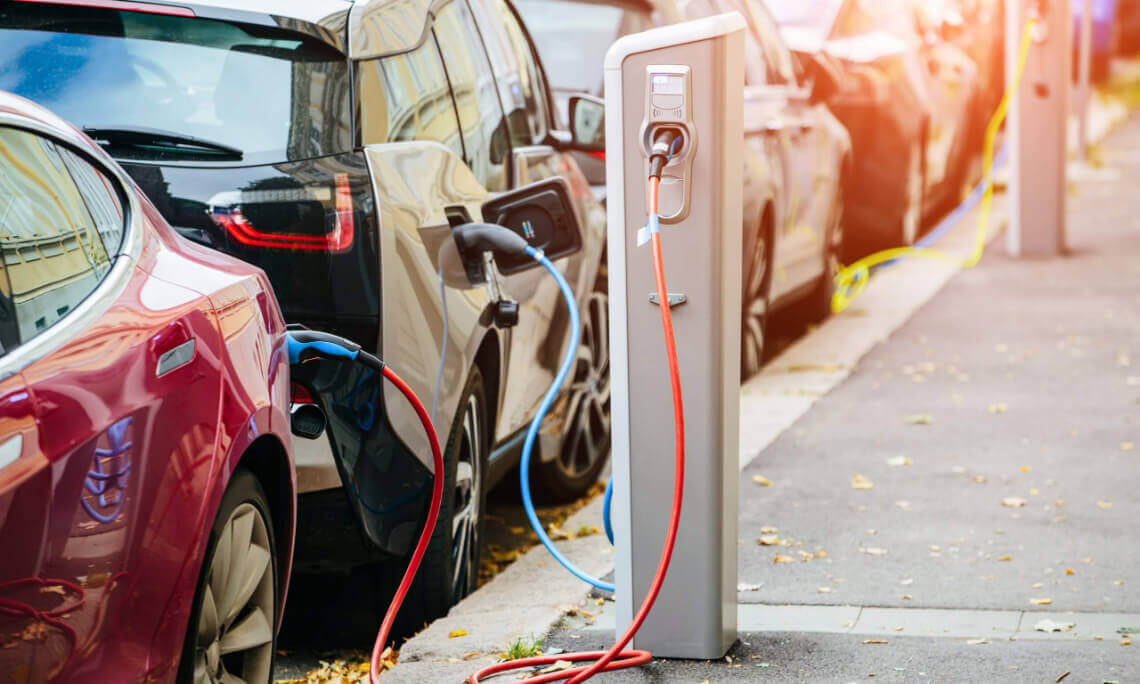
While the future holds great promise for electric cars and recharging technology, there is still a while to go before we see these different types of charging stations make an appearance across the world.
Electric cars and their recharging stations are only one aspect of an exciting future when it comes to travel.
Yes – car insurance companies offer cover for electric, petrol, hybrid and diesel vehicles. For electric vehicles specifically, you could be covered for a few additional scenarios that are unique to your type of car, such as faulty charger starting a fire. However, this would depend on your level of cover. As a general rule, you should always check the Product Disclosure Statement (PDS) before purchasing a policy, as it will outline any inclusions and exclusions.
To establish which countries we would explore with concept graphics of electric and hydrogen car charging and refuelling stations, we selected countries which recorded some of the highest numbers for electric car sales for the 2019 calendar year.42,43,44
Brought to you by Compare the Market: Making it easier for Australians to search for great deals on Car Insurance.